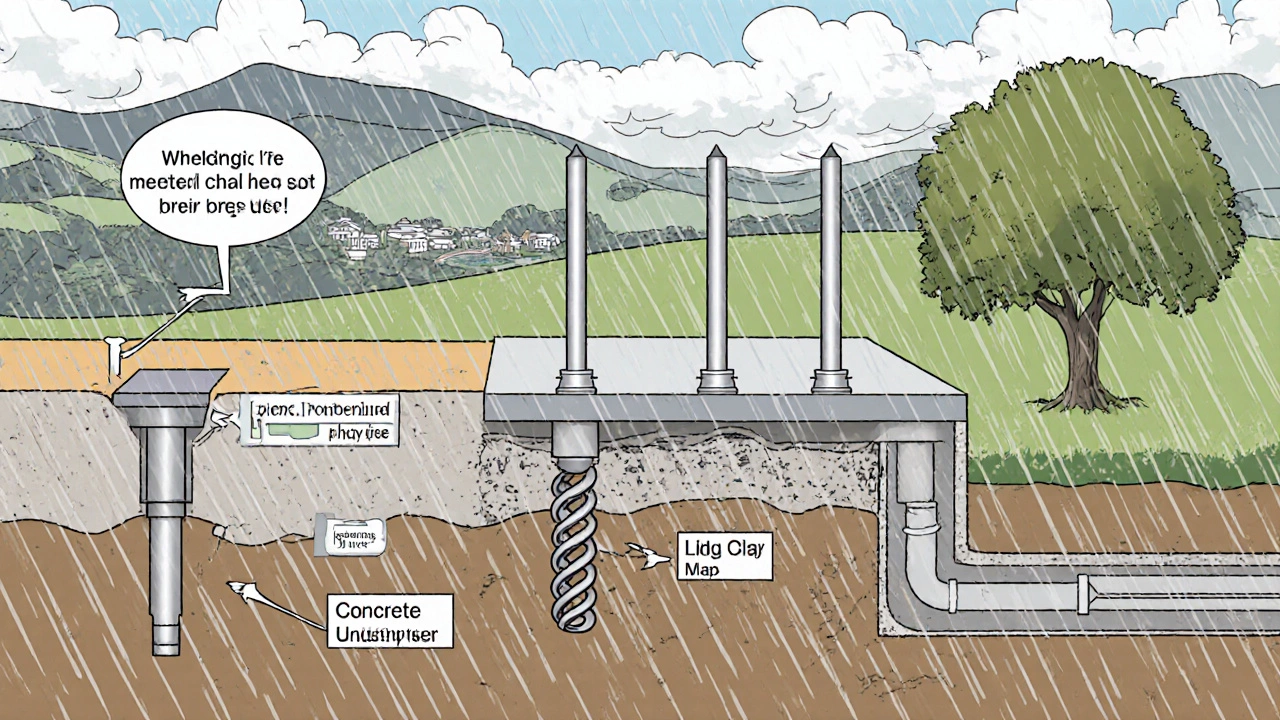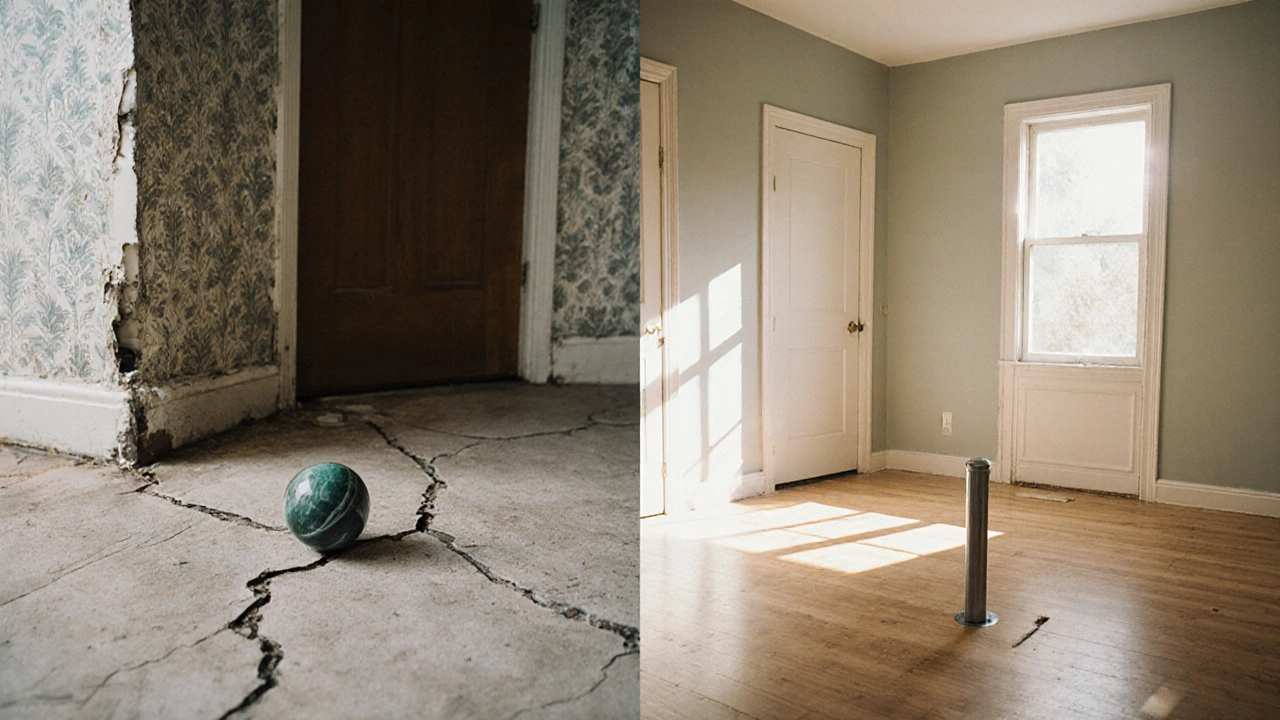Does Foundation Repair Really Work? Real Results from New Zealand Homes
 Nov, 2 2025
Nov, 2 2025
When your walls start cracking, doors stick, or floors slope like a ski run, it’s natural to wonder: foundation repair really work? Or is it just a costly band-aid that won’t last? If you’re sitting in a Wellington home watching the cracks grow wider every winter, you’re not alone. Thousands of homeowners here face the same fear-spending thousands on repairs only to see the same problems return. The truth? Foundation repair works-but only when it’s done right, for the right reason, and with the right method.
Why Foundations Fail in New Zealand
New Zealand’s geology and climate are unique. We have clay-rich soils in places like Porirua and Hutt Valley that swell when wet and shrink when dry. Then there’s the seismic activity-earthquakes, even small ones, can nudge foundations out of alignment. Add in aging drainage systems, tree roots growing under slabs, and poor original construction, and you’ve got a perfect storm for foundation trouble.Most homes built before 1990 here used concrete slabs on shallow footings. They weren’t designed for the heavy rainfall we now get. A 30-year-old house in Lower Hutt might have settled unevenly by 15-25mm over time. That’s not just cosmetic-it’s enough to crack plaster, misalign windows, and stress plumbing lines. And if you ignore it? That 20mm shift can become 50mm. And then you’re looking at structural damage.
What Foundation Repair Actually Does
Foundation repair isn’t about painting over cracks. It’s about restoring vertical alignment and stopping movement. There are three proven methods used here in New Zealand:- Steel piers-steel tubes driven deep into stable soil or bedrock, then used to lift and stabilize the foundation. They’re common in Wellington’s hilly suburbs where clay meets rock.
- Helical piers-screw-like steel shafts twisted into the ground. They’re less invasive and great for tight spaces like under decks or narrow side passages.
- Concrete underpinning-building new, deeper footings beside or under the existing ones. This is slower and messier but often used for large commercial buildings or homes with major settlement.
Each method has a job: stop movement, lift the structure back into place, and lock it there. The goal isn’t to make your house look brand new-it’s to make it safe, level, and stop further damage. A good repair won’t erase every crack. But it will stop the cracks from getting worse.
Real Results from Wellington Homes
In 2023, a Wellington-based structural engineering firm tracked 142 homes that had steel pier repairs done between 2018 and 2022. Here’s what they found:- 94% of homes stopped settling after repair.
- 87% saw doors and windows operate smoothly again within 30 days.
- Only 3 homes needed a second repair within five years-and those were due to new landscaping that redirected water toward the foundation.
One homeowner in Tawa had a 40mm dip in her living room floor. After installing 12 steel piers, the floor was lifted back to within 5mm of level. She didn’t need to replace her kitchen cabinets or retiling. Just fixed the root cause.
Another case: a 1960s brick bungalow in Lower Hutt with 60mm of differential settlement. The owner tried filling cracks with epoxy and repainting. It looked fine for six months-then the cracks returned, wider. After steel piers, the house has been stable for six years. No new cracks. No more sticking doors.

When Foundation Repair Doesn’t Work
It’s not magic. And it won’t fix everything. Here’s when it fails:- Water isn’t controlled-If your gutters are clogged, downpipes drain into the soil next to your foundation, or your garden slopes toward the house, repair will be wasted. Water is the #1 cause of ongoing movement.
- Tree roots are ignored-A large pine or poplar within 3 meters of your foundation can pull moisture from the soil and cause shrinkage. Repair the foundation but leave the tree? It’ll keep pulling.
- Wrong method chosen-Using helical piers on a house sitting on unstable fill soil? They might not reach solid ground. Steel piers need to go deep enough. A good contractor will do a soil test before quoting.
- Too many quick fixes-Some companies offer “no lift” epoxy injections or surface grouting. These seal cracks but don’t stop movement. They’re temporary. And they can hide bigger problems.
One family in Upper Hutt paid $12,000 for epoxy injections. Two years later, their walls cracked again. They ended up spending $28,000 on steel piers. The first fix didn’t fail-it was never meant to fix anything.
How to Know If You Need It
You don’t need to wait for a house to collapse. Watch for these signs:- Diagonal cracks wider than 3mm in brickwork or plaster
- Doors or windows that stick or won’t close fully
- Uneven floors-roll a marble across the room. If it rolls, the floor slopes.
- Ceilings separating from walls
- Cracks in the driveway or patio that line up with the house’s foundation
If you see two or more of these, get a professional inspection. Don’t wait for the cracks to get wider. Foundation movement doesn’t reverse itself. And the longer you wait, the more expensive the fix becomes.
What to Look for in a Foundation Repair Company
Not all contractors are equal. Here’s what matters in New Zealand:- They test the soil-Ask for a simple cone penetration test or borehole report. If they skip this, walk away.
- They use licensed engineers-The repair plan should be signed off by a registered structural engineer.
- They offer a written warranty-Look for at least 10 years on piers. Some offer lifetime warranties, but read the fine print. It shouldn’t be voided if you plant a tree.
- They don’t pressure you-A reputable company will give you options, not just the most expensive one.
Ask for before-and-after level readings. A good company will measure your floor slope before and after with a digital level. That’s how you know it worked.

Is It Worth the Cost?
Foundation repair in New Zealand typically costs between $12,000 and $35,000, depending on the size of the house and how many piers are needed. That sounds steep. But consider this:- A cracked foundation can reduce your home’s value by 10-20%.
- Unrepaired movement can cause plumbing leaks, electrical hazards, and mold from damp walls.
- Insurance may deny claims if you didn’t fix known foundation issues.
- Re-sloping a floor or replacing cracked bricks after major settlement can cost more than the repair itself.
Think of it like fixing a leaky roof. You don’t wait until the ceiling collapses. You fix it before the rot spreads.
What Happens If You Do Nothing?
Ignoring foundation movement is like ignoring a toothache. At first, it’s just uncomfortable. Then you can’t eat properly. Then you lose the tooth. And then you need a whole new jaw.Over time, uneven settlement causes:
- Cracked bricks that let in water
- Broken pipes inside walls
- Electrical wiring pulled tight and frayed
- Mold from trapped moisture behind walls
- Structural failure in load-bearing walls
In extreme cases, homes become unsafe to live in. That’s not a hypothetical. In 2022, a house in Lower Hutt was condemned after 12 years of ignored settlement. The owners lost their home-and their insurance payout.
Can foundation repair fix a house that’s already leaning?
Yes, in most cases. Steel or helical piers can lift and level a home even if it’s visibly leaning. The key is how much movement has occurred and whether the structure is still intact. Homes with severe leaning (over 50mm) may need additional structural support, like steel beams or wall braces, alongside piers. But lifting a tilted house back to level is a standard procedure for experienced contractors.
How long does foundation repair last?
Properly installed steel or helical piers are designed to last the life of the building-often 50+ years. They’re made of galvanized or coated steel and are anchored into stable soil or bedrock. The warranty usually covers 10-25 years, but the piers themselves rarely fail if installed correctly. The real risk isn’t the piers-it’s what happens around them. Poor drainage or tree roots can still cause movement, so ongoing maintenance matters.
Will foundation repair increase my home’s value?
Yes. A repaired foundation removes a major red flag for buyers and lenders. In Wellington’s market, homes with documented, professional foundation repairs often sell faster and for 5-15% more than similar homes with unresolved issues. Buyers don’t want to inherit a money pit. A repaired foundation turns a liability into a selling point.
Can I do foundation repair myself?
No. Foundation repair requires heavy equipment, engineering knowledge, and structural calculations. DIY solutions like concrete patches, epoxy injections, or adding bricks won’t stop movement. They only mask the problem. In New Zealand, structural work like this requires a building consent. Doing it without one can void your insurance and make future sales impossible.
How long does the repair process take?
Most residential foundation repairs take 2-5 days. The actual lifting happens in a day or two. But preparation-moving furniture, setting up equipment, getting permits-adds time. After the repair, you’ll need a few days for the house to settle into its new position. Cracks may still appear in plaster as the structure adjusts. That’s normal. Full stabilization usually takes 2-4 weeks.
Next Steps
If you’re seeing signs of foundation movement, don’t panic. But don’t delay either. Get a free inspection from a licensed structural engineer or a contractor who works with one. Ask for a written report that includes:- Current settlement measurements
- Recommended repair method
- Estimated cost and timeline
- Warranty details
Compare at least two quotes. Don’t choose the cheapest. Choose the one with the clearest plan and the strongest warranty. And always, always fix your drainage first. No repair lasts if water keeps attacking your foundation.
Foundation repair isn’t glamorous. But it’s one of the most important things you can do to protect your biggest investment. In New Zealand’s changing climate, it’s not a luxury-it’s a necessity.
